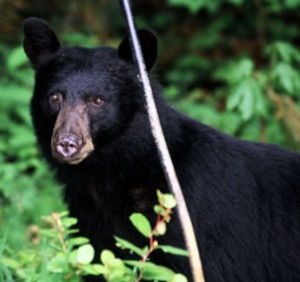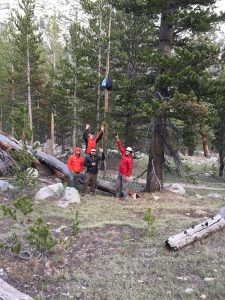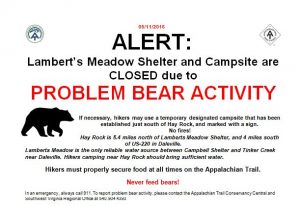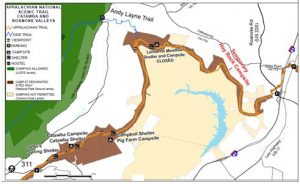What to do when a bear wants your food
What should you do when you are on the trail and a bear wants your food? Get a copy of the tips shown below from  the Virginia Department of Game and Inland Fisheries here.
the Virginia Department of Game and Inland Fisheries here.
To help yourself and others:
- NEVER leave food in shelters or anywhere else near the trail. This is the cause of current bear problems – it is really a human problem more than a bear problem.
- ALWAYS hang a bear bag or use a bear canister or other bear-proof storage system at night.
 The bag itself should be at least 12 feet up in the air – so that a bear cannot reach it from the ground – and 6 feet out from the main tree trunk (see photo).
The bag itself should be at least 12 feet up in the air – so that a bear cannot reach it from the ground – and 6 feet out from the main tree trunk (see photo).
Generally black bears are naturally wary/fearful of people and prefer to avoid contact. However, bears that have been purposely fed or gotten a food reward from people may lose this wariness. These bears may try to “scare” you into leaving your food or pack. They may pop their jaws or swat the ground with their front paws while blowing and snorting, and/or may lunge or bluff charge toward you in an attempt to get you to leave. These bluff charges rarely end in contact and should never be rewarded with food that is left unattended or thrown at the bear. Should you encounter a bear displaying this behavior:
- Do not run from a bear in any situation!
- Remain calm and ready your bear spray (or other deterrent like rocks or sticks).
- Stay together if you are in a group; you will appear larger and more intimidating if you stick together.
- Act aggressively. Look the bear straight in the eyes and let it know you will fight. Shout! Make yourself look as big as possible. Stamp your feet. Threaten the bear with whatever is handy (stick, pole, bear spray). Throw rocks or sticks (never throw anything edible!). The more the bear persists, the more aggressive your response should be.
- If a bear that is behaving in an aggressive/threatening manner is intent on making contact, your first line of defense is always your bear spray. Point the nozzle just above the bear’s head so that the spray falls into the bears eyes, nose and throat. When it is 20 to 30 feet away, give it a long blast. That should be enough to discourage it and send it in the other direction. (Be cautious of wind direction)
- Once the bear has moved away, retreat to a safe location. Take your food/pack with you. Do not run. Stay alert in case the bear returns.
- Notify your local Appalachian Trail contact, Sheriff’s Department or Virginia Department of Game and Inland Fisheries about your encounter.
Appalachian Trail Conservancy Central and Southwest Virginia Regional Office at 540.904.4393
Virginia Department of Game and Inland Fisheries 804.652.7921


